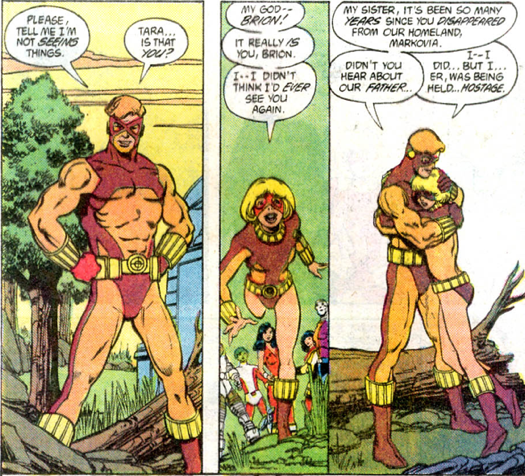
Anita Fite’s grandmother was a voodou priestess who relocated from Haiti to the Louisiana bayou, where she raised Anita’s mother. When Anita’s mother met and married Donald Fite, agent of the government’s All Purpose Enforcement Squad (A.P.E.S.), the young couple permitted Anita’s grandmother to beseech the gods’ favor for their unborn child.
Whether it was divine intervention or not, young Anita was born with enhanced athleticism, plus a piece of the Anti-Life Equation in her brain that allowed her to telepathically command others to do simple tasks. Her grandmother finished the job by training Anita in voodou, giving her the ability to perform various spells and teleport.
Years later, Anita happened to be at the mall when she witnessed Cissie King-Jones (who had just hung up her Arrowette mantle) stopping a thief, and was inspired to become a vigilante. Taking the codename Empress, she started hanging around Young Justice in a semi-creepy fashion, every so often stepping in to save their bacon. Eventually she officially joined the team, started a sort-of romance with Li’l Lobo/Slo-bo, and even befriended her idol Cissie, who was initially hostile towards her ‘replacement.’
When Anita’s father was killed by the evil voodou practitioner Agua Sin Gaaz who, years before, had killed Anita’s mother Anita went after him seeking revenge. Instead, thanks to Sin Gaaz’s experiments with cloning and resurrection, she found her parents again, reborn as infants. She took a break from Young Justice (which was soon to disband anyway) to concentrate on raising her parents. Comics, everyone!
So What’s So Great About Her?
I’m not going to lie. There are aspects of Anita’s character that make me go ‘Wait, what?’ Like, did the only non-white member of Young Justice really have to be the voodou-spell-casting granddaughter of a voodou priestess? Did she really sometimes have to get naked to perform her oh-so-exotic-and-spooky bloodletting spells? And why does she speak with a Jamaican accent, mon, when she’s from Louisiana?
But if you can get past the problematic origin (unfortunately all too common with characters of color in comics) and train your eyes to gloss over the ‘accent,’ Anita is a welcome addition to the YJ crew. She’s witty and entertainingly badass. She’s open-minded enough to date someone like Li’l Lobo, and is able to see the humor in the inevitable farce that is their date. And though she has a certain amount of hero worship for Cissie, she’s both empathetic enough to understand why Cissie is being catty towards her when Anita takes her slot on the team, and bold enough to tell Cissie where to stick it when Cissie tells her to quit.
That last bit is important, because if Anita’s got anything, it’s the courage of her convictions. She becomes a superhero simply because she realizes that she wants to use her exceptional abilities to help sadly, a rarity for female characters. She charges fearlessly into danger both to rescue her father and to revenge herself upon his murderer (though due to plot machinations, she’s not the one who kills Sin Gaaz). And when she finds herself a bizarre comic book version of a teen mom, she goes right ahead and raises her parents (presumably A.P.E.S. is footing the bills?).
Anita hasn’t been seen much since the cancellation of Young Justice, though a guest spot in Supergirl shows that she’s still taking care of her folks even if that means fighting a Kryptonian. But she’s a great, fun character, and hopefully some writer will pull her out of limbo soon.
Notable Appearances
Young Justice #16-55
Titans/Young Justice: Graduation Day
Infinite Crisis #6
Wonder Girl miniseries
Final Crisis #1
Supergirl v5 #33Anita Fite (Empress)





